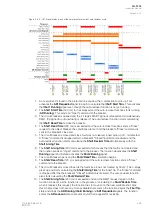
2. The SSho
hot1 Star
t1 Start T
t Time
ime (500 ms) for has elapsed and the auto-recloser function starts running
(AR Running
AR Running). This sends an "Open" command to the breaker.
3. The circuit breaker is opened and the I> stage's START signal is released and simultaneously
REQ1 trip signal for auto-reclosing is released. The auto-recloser function starts calculating
the SSho
hot1 Dead T
t1 Dead Time
ime to close the breaker.
4. The SSho
hot1 Dead T
t1 Dead Time
ime (200 ms) is exceeded and the auto-recloser function sends a "Close"
request to the object breaker: the conditions are met and the breaker's "Close" command is
sent to the breaker's close coil.
5. The circuit breaker is closed and since fault was not cleared, a new pick-up of I> is detected.
A "Close" command is dropped after the breaker's "Closed" indication is received and the
auto-recloser function starts calculating the SSho
hot1 R
t1 Reclaim
eclaim TTime
ime simultaneously with the
SSho
hot1 Ar
t1 Arcing T
cing Time
ime.
6. The SSho
hot1 Ar
t1 Arcing T
cing Time
ime (200 ms) is exceeded which means that the fault is not cleared and
the function sends an "Open" command to the breaker. The function deactivates the SSho
hot1
t1
Running
Running signal and instead activates the SSho
hot2 Running
t2 Running signal.
7. The circuit breaker opens and the SSho
hot2 Dead T
t2 Dead Time
ime calculation begins.
8. The fault is cleared during the SSho
hot2 Dead T
t2 Dead Time
ime (120 s). When that time is exceeded, the
auto-recloser function sends a "Close" command to the breaker.
9. The circuit breaker is closed and since the fault was cleared by Shot 2, no more pick-ups are
detected. The "Close" command is dropped after the the breaker's "Closed" indication is
received. The auto-recloser function also starts calculating the SSho
hot2 R
t2 Reclaim T
eclaim Time
ime.
10. The SSho
hot2 R
t2 Reclaim T
eclaim Time
ime (10 s) is exceeded, and so the AR Running
AR Running, SSho
hot2 Running
t2 Running and
AR1
AR1 R
Request
equested
ed signals are terminated and the AR R
AR Reclaim
eclaim calculation begins. The difference
between auto-reclosing and shot-specific reclaim times is that the function jumps to the next
available shot should the fault returns. If a fault returns after a successful cycle and the
function's AR Reclaim signal is active, the function jumps directly to the Final Trip state and
then enters the lock-out state. The user can control this behavior through the function
settings. Both reclaim times can be set to 0 s when they are not needed, and the function
skips all timers that are set to zero. The user can also set is so that AR Reclaim is not used at
all after a successful recloser cycle.
11. The AR R
AR Reclaim
eclaim time is exceeded and the function is set to "Ready" to wait for the next
request.
Auto-recloser sequence from Start with two shots (high-speed succeeds).
This auto-recloser scheme has the same starters and shots as the two previous examples. The setting
and signals are also the same. However, in this example the fault is cleared by the high-speed shot.
Figure. 5.4.4 - 190. Settings for I> with two shots.
This type of sequence (i.e. the first shot clears the fault) represents 75...85 % of all faults that occur in
MV overhead line networks.
A
AQ
Q-F205
-F205
Instruction manual
Version: 2.04
© Arcteq Relays Ltd
IM00013
271
Summary of Contents for AQ F205
Page 1: ...AQ F205 Feeder protection IED Instruction manual ...
Page 2: ......















































